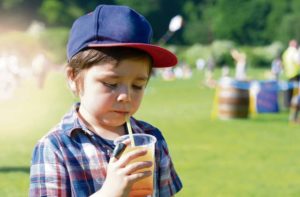What are sugar-sweetened beverages?
Sugar-sweetened beverages are defined by the Centers for Disease Control and Prevention to include soft drinks (soda or pop), fruit drinks, sports drinks, tea and coffee drinks, energy drinks, sweetened milk or milk alternatives and any other beverages to which sugar has been added.
How many SSBs do kids and teenagers consume?

According to the Centers for Disease Control, 62.9 percent of American youth (ages 2-19 years) consume at least one sweetened beverage per day. Drinks containing sugars are a quick and easy option to quench one’s thirst and/or satisfy a sugar craving due to their low cost and accessibility. Therefore, it is no surprise to find that many kids and teens often reach for soft drinks, sports drinks, or other sugar-sweetened beverages before water.
What happens to your teeth when you consume SSBs?
Bacteria in the mouth consume the sugars in SSB and produce acid as a waste product. The acid sits on the tooth and slowly breaks down the enamel, the outermost layer of the tooth. Enamel is the strongest substance in our body, but over months and years of acid attack even tough enamel can be broken down.
How long does the acid attack the tooth?
In order to consider the length of the acid attack, it is important to consider pH balance. A pH of 0 is acidic, a pH of 7 is neutral and a pH of 14 is basic. The mouth naturally has a neutral pH balance ranging from 6.7 to 7.3. However, every time an SSB is consumed, the pH balance in the mouth drops into the acidic range of 5.5 or below for a minimum of 20 minutes! Worst of all, the timer restarts with each sip!
What about 100 percent juice products?
A June 2017 recommendation of the Committee on Nutrition of the American Academy of Pediatrics (AAP) has reconfirmed that 100 percent juice and juice drinks have NO essential role in a healthy diet for children. In fact, juice contribute to excessive calorie intake and increase the risk of dental caries in children.
What is the recommended consumption of SSBs for each age group?
The current recommendations of the American Academy of Pediatrics (AAP) and the American Academy of Pediatric Dentistry (AAPD) states:
- Juice should not be introduced to infants before one year of age
- Intake of juice should be limited to four ounces/day for children ages 1–3 years of age
- Intake of juice should be limited to four to six ounces/day for children ages 4-6 years of age
- Intake of juice should be limited to eight ounces/day for children ages 7-18 years of age
- *Toddlers should not be given juice in containers that foster easy consumption, like bottles and sippy cups
- *Toddlers should not be given juice at bedtime
References:
- “Sip All Day, Get Decay – Oral Care Tips.” WDA, https://www.wda.org/your-oral-health/sip-all-day.
- NCHS Data Brief No. 271 January 2017
- Sugary Drinks Consumption among Children and Teens,
https://www.safefood.eu/Professional/Nutrition/Nutrition-News-en/Nutrition-News/February-2017/Sugary-drinks-consumption-among-children-and-teens.aspx. - “Cutting out Sugary Drinks for Kids.” Obesity Prevention Source, 8 Apr. 2016,
https://www.hsph.harvard.edu/obesity-prevention-source/cutting-out-sugary-drinks-for-kids/. - https://www.aapd.org/research/oral-health-policies–recommendations/dietary-recommendations-for-infants-children-and-adolescents/


